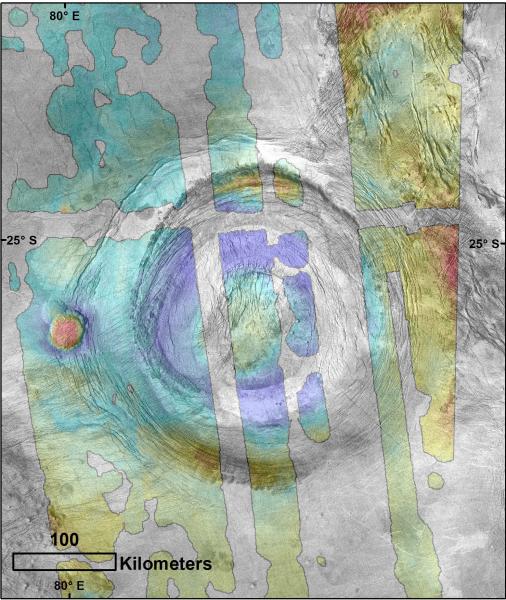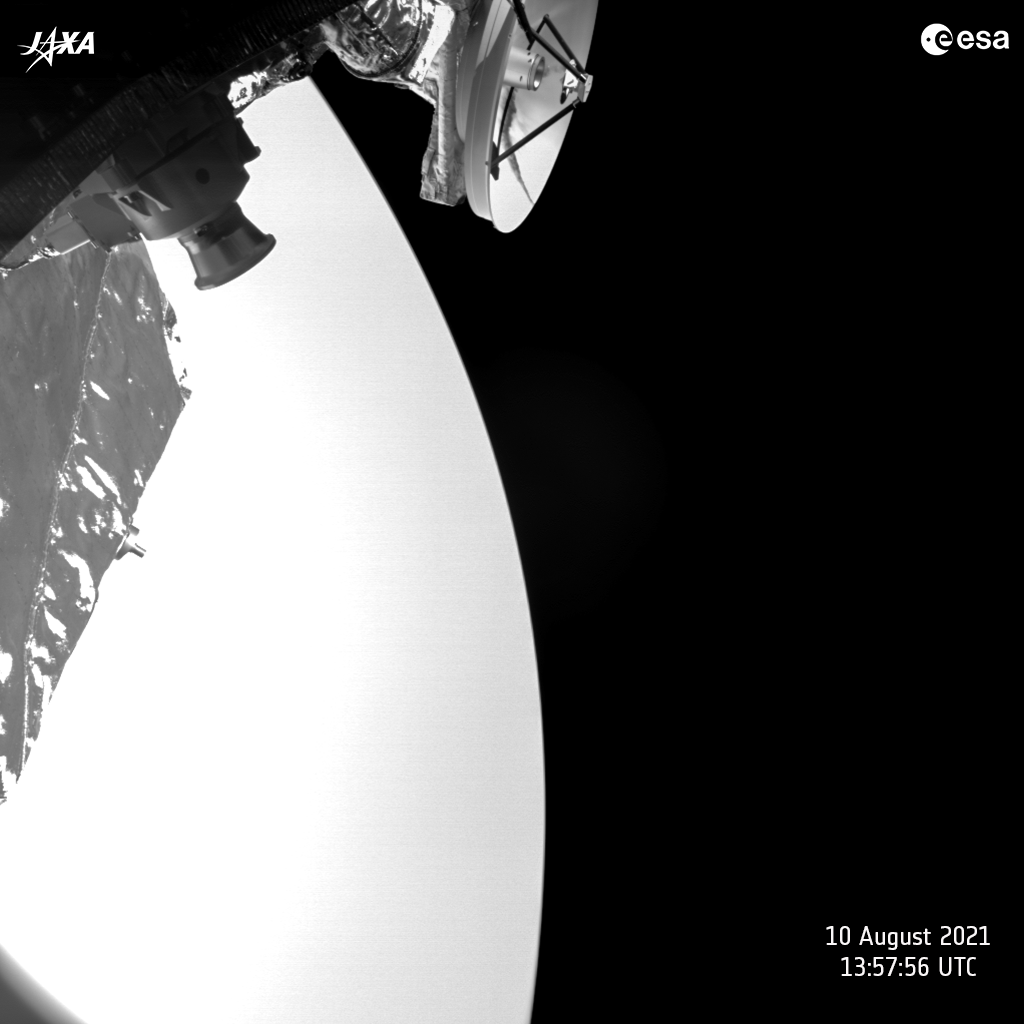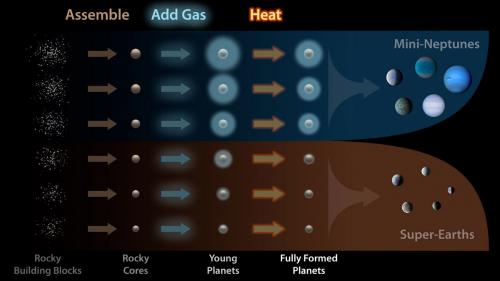After careful analysis of orbital data, gravitational forces, and several other factors, NASA’s OSIRIS-REx team calculated the risk of a collision with near-Earth asteroid Bennu to be 0.057% through 2300. Plus, magnetites in meteorites reveal solar system history, and the constellation Ophiuchus is What’s Up.
Podcast
Transcript
Hello and welcome to the Daily Space. I am your host Dr. Pamela Gay.
And I am your host Beth Johnson.
And we are here to put science in your brain.

It is one of those blistering hot days for both Pamela and me when you really wish it was safe and affordable to just go to the movie theatre and watch movies and eat popcorn all day long. Since it is neither safe nor affordable, we’re instead going to remind you things could be much much worse and talk about Venus for a bit.
This nearby world could have a climate not too different from ours if its atmosphere was a bit different, but due to something rather horrible that happened at some point in the past, Venus transformed from a water world to a death world where temperatures hang out around 900˚F or 475˚C.
One possible idea for the cataclysm is a massive round of volcanic eruptions. This would explain why Venus doesn’t have a lot of craters. As with many things in science, however, more than one answer is possible, and while a single round of “all of Venus erupts at once” would work, a less dramatic round of volcanoes popping up everywhere over time would also work. And of course, both could be true at once. While we can’t easily rule out “both happened” it is possible to look at the “was there one epoch of volcanism” versus “is there ongoing volcanism”. All you have to do is find active or recently active volcanoes.
And it appears one group of researchers here at the Planetary Science Institute have found one volcano that erupted 300 million to one billion years ago. What makes this discovery particularly lucky is that it required the use of Magellan data from the 1990s, and only a small region of Venus was measured in high enough resolution by the correct combination of instruments to make this detection possible.
The feature that was examined is called a corona, which is Latin for crown, and it is cool to think that these ancient crowns on Venus are sites that record its history. We can’t wait for more missions to make it to this too-hot world and help us image more of these structures and unravel the mysteries of Venus’ past.

Speaking of new data on Venus, the ESA–JAXA spacecraft BepiColombo flew past Venus on August 10 on its way to Mercury. Because its cameras are designed to look at a rocky dark planet and not a highly reflective layer of clouds, the images it captured mostly just show a hot, round thing. Which, to be fair, is what Venus is. It’s just nice when we can resolve features in the clouds.
In addition to showing us a big round Venus, the images also capture bits of the spacecraft and showcase just how well the spacecraft’s cameras work, which was the real goal of these images. When missions fly past secondary targets, it allows the missions teams a chance to test their instruments and provides them with time to fix anything that might need to be fixed prior to arriving at their final destination. In this case, if the software for the cameras had done something weird, which it didn’t, the team behind BepiColombo would have had time to fix things before the craft gets to Mercury in 2025.
As frustrating as it may be that we can’t send missions to planets in our solar system more often (and it’s oh so very frustrating), it’s even more frustrating for folks studying planets around other worlds who can’t imagine ever sending spacecraft to the worlds they discover. Not only that, but the things we are most interested in studying – the evolution of planets over time – takes place at such a long scale that we can’t even dream of seeing one system evolve from start to finish on human timescales.
So instead, we look at as many systems as possible and try to build a consistent story.

One of our great frustrations is we keep seeing systems with a ton of rocky worlds way bigger than Earth and a myriad of tiny Neptunes smaller than the ice giants we have here. We actually see so many of these worlds that it’s weird we don’t have either in our solar system. And we don’t see any worlds in between these two types in size.
New work using TESS data adds evidence to the idea that this division is due to the ability of worlds to hold onto their atmospheres. It is thought that planets start with a continuous range of sizes, but there is a point at which a planet can either keep its extended atmosphere like a Neptune or that it is forced to lose that atmosphere to forces like stellar winds. That gap we’re seeing in mass is the difference in mass between a rocky super-Earth with and without its extended atmosphere.
It is going to be interesting to see how this trend works with stars of different types and such, but it feels like we are finally on the right path to understanding at least one part of planetary formation.
Another common body in our solar system is the asteroid. We have a lot of them. Thousands of them, in fact. And recent missions have been focused on understanding these tiny worlds, in part because some of them have a chance of hitting Earth. Unlike the dinosaurs, we have scientists working on this problem, which is good for us. That’s really what NASA’s OSIRIS-REx mission is about — understanding just how the near-Earth asteroid Bennu moves in its orbit, what it is composed of, how it is structured, etc. All of these characteristics are tied together to determine what kind of threat Bennu poses for Earth.
At a press conference this week, NASA announced that after analyzing Bennu’s orbit with the Deep Space Network and some advanced computer modeling, they have calculated the change of an impact between now and the year 2300 as being about 1 in 1,750 or 0.057%. The single most significant date in that time period is September 24, 2182, when the impact probability increases to a whopping 0.037% or a 1 in 2,700 chance. Yeah, not the big threat a few dozen early articles made Bennu out to be.

This doesn’t mean that Bennu isn’t a hazard. It still is. NASA referred to it in their press release as “one of the two most hazardous known asteroids in our solar system.” The other asteroid is 1950 DA, whose current risk assessment is between 0 and 0.33% probability of causing an impact with Earth, and that threat is greatest in the year 2880. Yes, you heard that correctly — 2880. I’m not going to lose sleep over either of these asteroids.
The fascinating part of this new calculation is just how detailed the measurements and factors considered were. The team considered how the Sun heats up the asteroid’s dayside, which then affects the spin of the asteroid as the heated surface rotates away and cools down. Infrared energy gets released during the cooling process, and that energy actually generates a small amount of thrust for the asteroid, called the Yarkovsky effect. Now, on a day-to-day basis, this effect is negligible, but over the span of centuries, the change in orbit can add up.
So how much of an effect does this amount to for Bennu? Steve Chesley, a senior research scientist at JPL and study co-investigator says: The effect on Bennu is equivalent to the weight of three grapes constantly acting on the asteroid – tiny, yes, but significant when determining Bennu’s future impact chances over the decades and centuries to come.
Three grapes. I’m really not feeling threatened here, everyone.
Oh, but wait. Didn’t we sort of smack the asteroid while we were sampling it last year? It was supposed to be a gentle boop but instead turned out to be a half-a-meter plunge into the asteroid. How much of an effect did that event have on the orbit of Bennu? Rich Burns, OSIRIS-REx project manager at NASA’s Goddard Space Flight Center answers: The force exerted on Bennu’s surface during the TAG event [was] tiny even in comparison to the effects of other small forces considered. TAG did not alter Bennu’s likelihood of impacting Earth.
Good. We didn’t make things worse for us. And at a 0.057% probability, I’m still not feeling concerned about Bennu. Overall, this result is an impressive use of data collected by the OSIRIS-REx mission. As principal investigator Dante Lauretta explains: The orbital data from this mission helped us better appreciate Bennu’s impact chances over the next couple of centuries and our overall understanding of potentially hazardous asteroids – an incredible result.
Now we wait for the spacecraft to return to Earth and bring us that precious sample it collected, which we hope helps us further understand not only the composition of Bennu itself but also the history of our solar system. Go go, little spacecraft!
I have to admit, most of what I learned in elementary and middle school has either just been incorporated into my knowledge base or utterly forgotten. There are a few things I seem destined to never forget, like the Kookaburra song I learned in second grade when we studied Australia. And, much more usefully, the lessons we did on magnets in sixth grade.

I distinctly remember learning that new magnets can be made in three different ways: you can pound on something containing iron and similar elements until all the minerals are shocked into aligning and making a magnet. You can store an existing magnet with something metal, and let the magnet’s field slowly turn the metal item into a magnet; this is something a lot of grandmas taught their grandkids to do with scissors to make it easy to pick up needles. You can also run electricity through loops of wire, or orbit charged particles, and make an electromagnet. These are all a lot of fun and perfect activities for sixth graders… and early solar systems.
Baby solar systems may have magnetic field forming disks. These die off as planets start forming and stars settle down a bit. Then the collisions start — the kinds of collisions that can generate magnetic fields in rocks and send objects flying across the solar system. And it’s kind of awesome.
In new research looking at samples of the Tagish Lake Meteorite, scientists were able to use these smash-induced magnetic fields to study the history of this particular space rock. Chemical analysis indicates the Tagish Lake Meteorite started its life somewhere out in the Kuiper belt, near or beyond the modern orbit of Neptune. This happened early on – just three million years or so after the solar system began to form and before Jupiter really started its reign. Once Jupiter came along, it started rearranging the solar system with its gravity, and this yanked the rock that would one day hit Earth out of the Kuiper belt and moved it into the asteroid belt.
This wasn’t an easy transition. It appears that that the rock was heated to 250˚C through a combination of the decay of radioactive minerals and an orbit-changing collision. This combo produced a lasting magnetic field. How the space rock made it from the asteroid belt to Earth is still a mystery, but whatever happened, it brought us some super cool data. According to lead scientist Yuki Kimura: Our results help us infer the early dynamics of Solar System bodies that occurred several million years after the formation of the Solar System, and imply a highly efficient formation of the outer bodies of the Solar System, including Jupiter.
These results appear in The Astrophysical Journal Letters.
What’s Up

A lot of people don’t realize that there is super important science you can do with your unaided eye. There is, and one of my favorite tasks, for those with a good memory, is watching the sky for novae.
Unlike supernovae, which destroy the system they are in, novae are events of many different kinds that cause a stellar remnant to suddenly increase in brightness in ways that make for cool science. Since there are a lot of these explody stars in the sky, professional astronomers can’t easily monitor all of them all of the time, but there are a lot of amateur astronomers who have memorized the locations of their favorite systems and then check the sky for new novae as they walk from their work to their car or their car to their house.
And last week, two such observers, Keith Geary of Ireland and Ernesto Guido of Italy, spotted the star RS Oph in an outburst. This is a recurrent nova. This system has a tiny, dense white dwarf star that is eating material off a companion. Once enough of this consumed material piles up, the white dwarf goes nuclear and lights up the system. In this case, the system’s brightness increased by over a factor of 600 and went from something you can only see with a telescope to something you can see with your eye. We have finding charts on our website, DailySpace.org, and we encourage all of you – weather permitting – to go out and see this new and temporary star and then watch as it fades away.
If you haven’t heard of the constellation Ophiuchus before, it’s the constellation of the serpent bearer, and for a bunch of us born in December, it’s the constellation the Sun was in on the day of our birth. Ophiuchus and its serpents are nestled between Sagittarius, Scorpio, and Hercules. As to why this zodiac sign is left out and ignored, and folks like me are told we were born in Sagittarius, I’m just a scientist. And this is a reminder that astrology doesn’t use the actual sky or science.
Instead of trying to guess at the reasoning of ancient Greeks, I’m going to go out, catch whatever lingering bits of the Perseids may still be out there, and enjoy myself a nova. Join me?
This has been the Daily Space.
Learn More
Volcanoes Crown Venus
- PSI press release
- “Evidence for a Locally Thinned Lithosphere Associated With Recent Volcanism at Aramaiti Corona, Venus,” M. B. Russell and C. L. Johnson, 2021 June 18, JGR Planets
BepiColombo Steals an Image of Venus
- ESA press release
Building Planets Into Rocky and Gassy Worlds
- Carnegie Science press release
- “The Magellan-TESS Survey I: Survey Description and Mid-Survey Results,” Johanna Teske et al., to be published in The Astrophysical Journal Supplement Series (preprint on arxiv.org)
Bennu Has Nearly Non-Existent Chance of Collision With Earth
- NASA press release
- “Ephemeris and hazard assessment for near-Earth asteroid (101955) Bennu based on OSIRIS-REx data,” Davide Farnocchia et al., 2021 August 10, Icarus
Magnets Pick Up History of Early Solar System
- Hokkaido University press release
- “Electron Holography Details the Tagish Lake Parent Body and Implies Early Planetary Dynamics of the Solar System,” Yuki Kimura, Kazuo Yamamoto, and Shigeru Wakita, 2021 August 11, The Astrophysical Journal Letters
What’s Up: An Explody Star in Ophiuchus
- Rare Naked-Eye Nova (spaceweatherarchive.com)
- A Rare Nova Visible To The Eye. See It While You Can! (EarthSky)
- Is Ophiuchus A Constellation Or A Sign? (EarthSky)
Credits
Written by Pamela Gay and Beth Johnson
Hosted by Pamela Gay and Beth Johnson
Audio and Video Editing by Ally Pelphrey
Content Editing by Beth Johnson
Intro and Outro music by Kevin MacLeod, https://incompetech.com/music/


 We record most shows live, on Twitch. Follow us today to get alerts when we go live.
We record most shows live, on Twitch. Follow us today to get alerts when we go live.